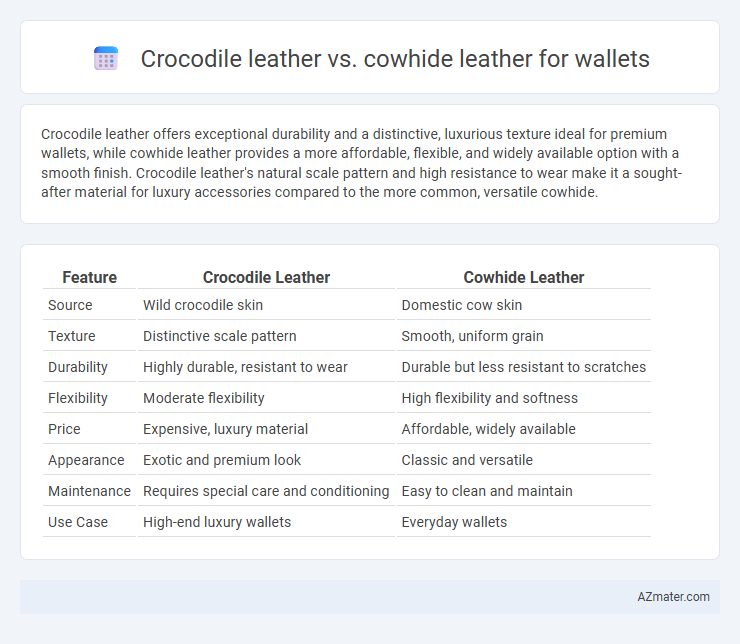Crocodile leather offers exceptional durability and a distinctive, luxurious texture ideal for premium wallets, while cowhide leather provides a more affordable, flexible, and widely available option with a smooth finish. Crocodile leather's natural scale pattern and high resistance to wear make it a sought-after material for luxury accessories compared to the more common, versatile cowhide.
Table of Comparison
| Feature | Crocodile Leather | Cowhide Leather |
|---|---|---|
| Source | Wild crocodile skin | Domestic cow skin |
| Texture | Distinctive scale pattern | Smooth, uniform grain |
| Durability | Highly durable, resistant to wear | Durable but less resistant to scratches |
| Flexibility | Moderate flexibility | High flexibility and softness |
| Price | Expensive, luxury material | Affordable, widely available |
| Appearance | Exotic and premium look | Classic and versatile |
| Maintenance | Requires special care and conditioning | Easy to clean and maintain |
| Use Case | High-end luxury wallets | Everyday wallets |
Introduction to Crocodile Leather and Cowhide Leather
Crocodile leather is prized for its distinctive scale patterns, durability, and natural water resistance, making it a luxurious choice for wallets that stand out in texture and exclusivity. Cowhide leather, derived from cows, offers versatility, strength, and affordability, featuring a smooth grain that develops a rich patina over time. Both materials provide excellent longevity, but crocodile leather is often favored for its premium appearance and rarity compared to the more accessible and widely used cowhide.
Appearance and Texture Comparison
Crocodile leather displays a distinctive, irregular scale pattern that creates a high-end, luxurious texture unique to exotic skins, while cowhide leather features a more uniform grain with a smoother surface. The glossy finish of crocodile leather enhances its rugged yet refined appearance, contrasting with the matte or semi-gloss sheen typically found in cowhide wallets. Crocodile leather is firmer and sturdier, offering a more structured feel, whereas cowhide provides a softer, more pliable texture that improves with age.
Durability and Lifespan
Crocodile leather offers exceptional durability due to its dense fiber structure and natural resistance to wear and tear, often lasting several decades with proper care. Cowhide leather, while durable and strong, tends to show signs of aging and wear more quickly, usually maintaining quality for 5-10 years under regular use. The lifespan of crocodile leather wallets significantly surpasses that of cowhide, making them a premium choice for long-lasting luxury accessories.
Cost Differences
Crocodile leather wallets typically cost significantly more than cowhide leather wallets due to the rarity and intricate texture of crocodile skin. Cowhide leather offers a more affordable option while still providing durability and a classic appearance. The price gap can range from several hundred to thousands of dollars, influenced by brand, craftsmanship, and the quality of the leather.
Maintenance and Care Requirements
Crocodile leather wallets require gentle cleaning with a damp cloth and periodic conditioning using specialized exotic leather conditioners to maintain their natural oils and prevent cracking. Cowhide leather wallets are more resilient, needing regular cleaning and conditioning with standard leather care products to avoid dryness and fading. Both types benefit from avoiding prolonged exposure to water and direct sunlight to preserve texture and color quality.
Ethical and Environmental Considerations
Crocodile leather is often criticized for ethical concerns due to the farming and hunting practices that can harm wild populations and disrupt ecosystems, whereas cowhide leather is generally more regulated but still raises issues related to intensive livestock farming, greenhouse gas emissions, and deforestation. Sustainable alternatives in both categories include sourcing from certified farms adhering to animal welfare standards and reduced environmental impact initiatives such as water recycling and eco-friendly tanning. Consumers aiming for eco-conscious choices frequently prefer cowhide from organic, traceable sources or consider synthetic leathers designed to minimize ecological damage.
Popularity and Status Symbol
Crocodile leather wallets rank higher in popularity due to their distinctive texture and rarity, often serving as powerful status symbols in luxury fashion. Cowhide leather wallets dominate the market because of their durability, affordability, and classic appeal, appealing to a broader consumer base. The exclusivity of crocodile leather enhances its prestige, while cowhide's widespread availability ensures consistent demand.
Versatility in Wallet Designs
Crocodile leather's unique texture and natural scale patterns provide an exclusive and luxurious appeal, making it ideal for high-end, statement wallet designs. Cowhide leather offers greater versatility in wallet designs due to its smooth surface, which accepts various finishes, colors, and embossing techniques, catering to both classic and modern styles. The durability and flexibility of cowhide also allow for a wider range of wallet shapes and functionalities compared to the more rigid crocodile leather.
Weight and Comfort
Crocodile leather wallets are typically lighter and more flexible than cowhide leather wallets, enhancing comfort during everyday use. The natural texture of crocodile leather offers a unique, supple feel that molds to the hand over time, while cowhide leather wallets tend to be thicker and heavier, providing more durability but less comfort. Choosing between these materials depends on the preference for lightweight elegance or robust longevity in wallet construction.
Final Verdict: Which Leather is Better for Wallets?
Crocodile leather offers exceptional durability, unique texture, and high luxury appeal, making it ideal for premium wallets that stand out in craftsmanship and exclusivity. Cowhide leather, known for its strength, affordability, and ease of maintenance, provides versatility and long-lasting comfort suitable for everyday wallet use. For those prioritizing prestige and distinctiveness, crocodile leather is superior, while cowhide leather remains the practical choice for functional and cost-effective wallets.

Infographic: Crocodile leather vs Cowhide leather for Wallet
 azmater.com
azmater.com